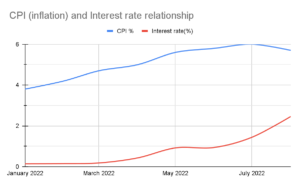November 4th, 2022
Inflation is one of the most vital metrics in our current economy that affects our everyday activities, even simple ones such as turning on the lights to having breakfast.
For example, if the inflation rate had been 3%, it would have cost 1.50$ to buy the same piece of bread, but if the inflation rate had been 10%, it might have cost 1.60$. Recent inflation rate data shows us that the inflation rate was 5.8% in June and 6.0% in July this year. The inflation rate is the percentage by which the value or purchasing power of your money has decreased. It is also known as the percentage that the price of goods/services has increased by. Essentially, you will have to pay more for everything because your money has less purchasing power. When the inflation rate increases, your money becomes less valuable each month, and the amount taken away surges each month; During those same months, the interest rate was around 2.8% in June and 3% in July.
Recent interest rates define how much you have to pay on top of a loan amount for borrowing that money and scale based on the loan amount. The interest rate is tied to inflation and will make a substantial difference in your future financial situation as many of you head closer to post-secondary education.
These mentioned statistics may be something to watch out for, as it affects your savings and any loans that might be necessary. To summarize, inflation is a meaningful metric that affects many parts of our everyday lives and has been increasing recently, causing a lot of concern. If you want to learn more about inflation, see this youtube video that explains everything else you need to know about inflation in only 10 minutes!
By Adrien Bourdeaux
Categories: Editorials

